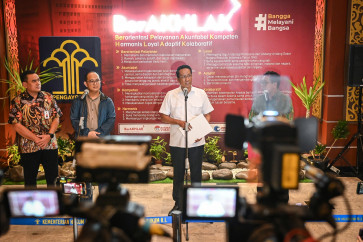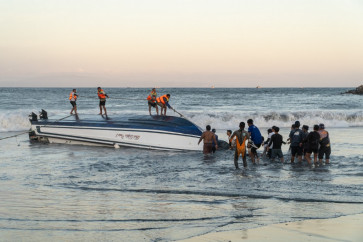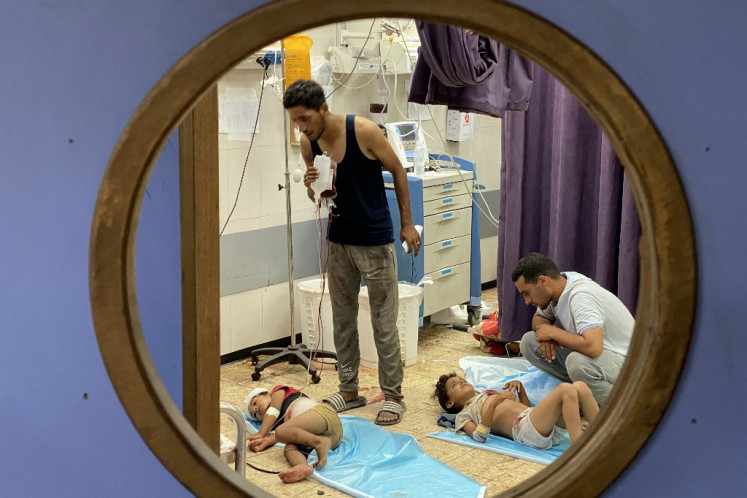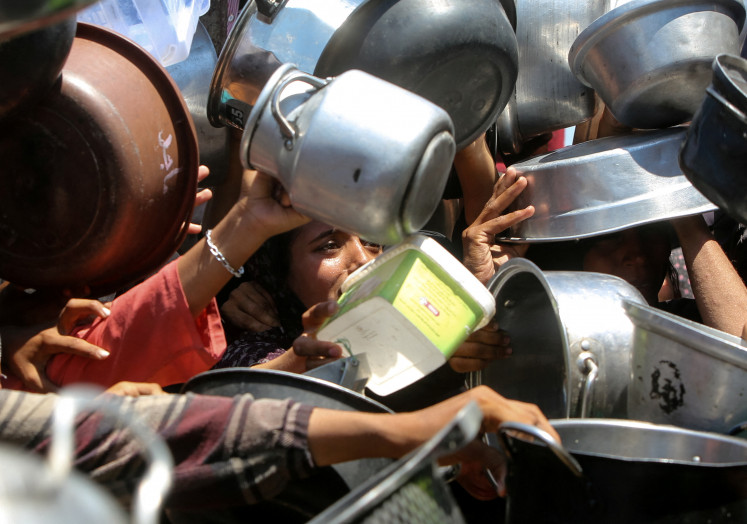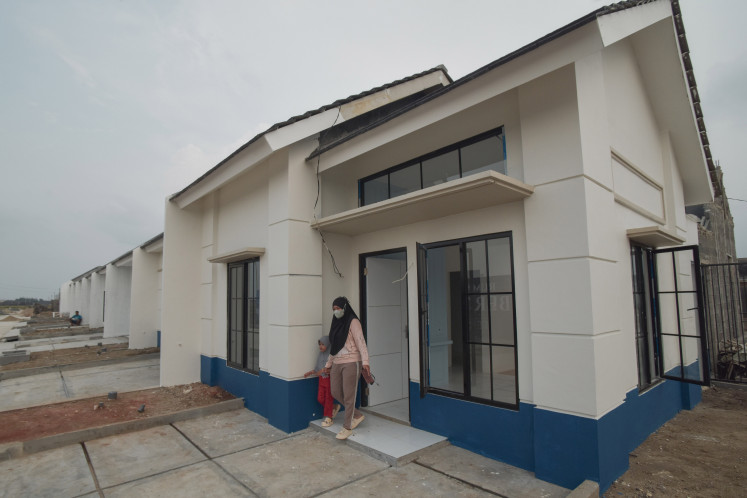Popular Reads
Top Results
Can't find what you're looking for?
View all search resultsPopular Reads
Top Results
Can't find what you're looking for?
View all search resultsThe rise & fall of Indonesian batik
Proud: A model showcases one of BaliJava exclusive Batik Kudus retail collection by designer Denny Wirawan on display at Alun Alun in Grand Indonesia shopping mall in Jakarta until Oct
Change text size
Gift Premium Articles
to Anyone
Proud: A model showcases one of BaliJava exclusive Batik Kudus retail collection by designer Denny Wirawan on display at Alun Alun in Grand Indonesia shopping mall in Jakarta until Oct. 19. (Courtesy of Image Dynamics)
Batik has penetrated deep into the lives of Indonesians, becoming not only a fashion statement but also a symbol of social status, history, nature and cultural heritage.
Batik can be found nationwide ' from Garut and Cirebon in West Java; Pekalongan and Surakarta in Central Java; Yogyakarta; Madura and Sidoarjo in East Java to other regions outside Java.
Batik textiles have a variety of motifs, styles and colors that are distinct from one region to another.
According to UNESCO, batik is craftwork dyed by craftspeople that draw designs on fabric using dots and lines of hot wax that resist vegetable and other dyes and allow the artisan to color selectively by soaking the cloth in one color, removing the wax with boiling water.
Such technique can also be found in India, Egypt, China and even the US, but Indonesian batik, especially in Java, is famous for the use of canting and wax. Its name is derived from the Javanese words 'amba' (to write) and 'nitik' (dots).
Following UNESCO's decision to add the traditional dyeing technique to its Intangible Cultural Heritage list, the Indonesian government declared Oct. 2 National Batik Day.
Since then, batik has gained popularity.
The journey of batik in Indonesia into the heart of modern society has always been surrounded by obstacles. The batik has struggled to survive, businessmen were forced to close their shops while workers began seeking jobs at factories owing to low demand in the market.
Batik Kudus, categorized as batik from the coastal area, once enjoyed high popularity in the 1920s, but its glory faded as batik artisans stopped making batik and worked in kretek (clove cigarettes) factories for better pay.
Miranti Serad Ginanjar of Galeri Batik Kudus said that in the 1950s, many batik owners had to shut down their businesses on account of low demand for batik tulis (hand-drawn batik), as batik cap (stamped) started to dominate the market.
She said that the local administration in Kudus, Central Java began reviving the local batik industry by encouraging prominent batik artisans to reopen their businesses and organize batik classes for younger folk.
Galeri Batik Kudus jumped in to help boost the batik industry in 2008.
'It wasn't easy to convince them to make batik again as they weren't being paid daily like when they worked in factories,' Miranti, who will soon launch a book entitled, Batik Kudus: The Heritage, said.
The government's decision to make Oct. 2 National Batik Day had in some ways motivated artisans to revive batik Kudus, she added.
Galeri Batik Kudus worked together with the Bakti Budaya Djarum Foundation and invited batik experts from Surakarta, Lasem and Pekalongan to Kudus to teach local batik makers how to make batik.
The batik they made was recently showcased in Denny Wirawan's solo fashion show, which highlighted batik Kudus. Since then, batik artisans in Kudus have become more passionate, enjoying the results of their hard work.
However, Miranti said, they still needed to learn more about managing their own products to stand on their own in the future.
'We also need more batik makers and local young entrepreneurs. I'm targeting more students from vocational schools here to participate in our workshops,' she said.
As batik Kudus has started to find its way to glory again, batik producers in Surakarta have recently been forced to reduce their hours and cut their workforce to control production costs, with sales of both handmade and printed batik products decreasing.
Sales have been falling since last year on weaker purchasing power as a result of higher staple food prices. Producers also saw an increase in production costs following the rupiah's drop in value against the US dollar, as some of the best-quality dyeing materials are imported.
Renowned designer Josephine 'Obin' Komara, who prefers to be called a cloth maker, said batik artisans had faced crisis throughout the years but proved that they would always survive.
'This is not the first time batik makers have faced crisis, but they have showed resilience,' Obin said.
She encouraged producers to get creative during difficult times, preparing strategies to deal with the problems.
'For example, if the price of red dye is high, we can use other colors instead. We should just make things with what we have around us,' she said.
Meanwhile, Creative Economy Agency head Triawan Munaf said that his institution had begun to map out strategies to tackle problems in the upstream and downstream, such as material availability, capacity building and promotion.
'We have a plan to set up creative centers across the country that will house creative products from all sectors that we're handling, including batik,' he said.
He added that all programs were expected to be implemented next year.
'UNESCO always monitors us. So if we don't show any serious efforts in developing strategies to preserve batik, there's a possibility that the status of batik as a UNESCO Intangible Heritage could be revoked,' he said.
'And it's everyone's responsibility to preserve the value of batik.'
Batik has also been a regular highlight at major fashion events, such as Jakarta Fashion Week and Indonesia Fashion Week. Batik-producing cities, such as Pekalongan and Surakarta also regularly hold batik fashion events to bring the art closer to people.
Owner of TIKprive batik fashion line and author of Cerita Batik (Batik Story) Wethandrie 'Iwet' Ramadhan said collaboration between designers and batik artisans were vital in preserving batik while at the same time, improving the skills and knowledge of batik artisans.
But designers should first understand the story behind batik before applying their signature style to it, he added.
'Before designing the clothes, we should carefully choose the motifs that we will use. If designers are aiming for contemporary looks, they should make their own motifs, or develop the old motifs,' Iwet said.
'We should all know that batik is more than just a piece of cloth ' it's a portrayal of a society, it's a story and it's a piece of fine art.'



